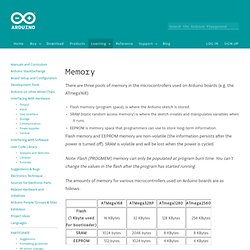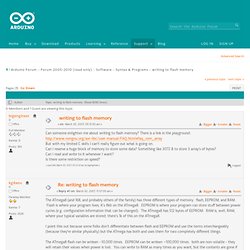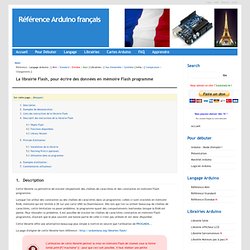

I2CEEPROM - Waterfox. Persistent Data on the Arduino (EEPROM) « modelrail.otenko - Waterfox. Memory - Waterfox. There are three pools of memory in the microcontrollers used on Arduino boards (e.g. the ATmega168): Flash memory (program space), is where the Arduino sketch is stored.

SRAM (static random access memory) is where the sketch creates and manipulates variables when it runs. EEPROM is memory space that programmers can use to store long-term information. Flash memory and EEPROM memory are non-volatile (the information persists after the power is turned off). SRAM is volatile and will be lost when the power is cycled. Note: Flash (PROGMEM) memory can only be populated at program burn time.
The amounts of memory for various microcontrollers used on Arduino boards are as follows: One thing you will notice in the chart above is that there is a lot more Flash (program) memory than SRAM available. Char message[] = "I support the Cape Wind project Version 1.0 of the Arduino IDE introduced the F() syntax for storing strings in flash memory rather than RAM. e.g. EEPROMex - Waterfox. The EEPROMex library is an extension of the standard Arduino EEPROM library.

It extends the functionality of the original Arduino EEPROM library with: Reading, writing to basic types. This includes bytes, longs, ints, floats and doubles. Reading, writing to single bits. This helps efficient usage of the limited EEPROM memory. You can download the library here: Writing to flash memory - Arduino Forum - Waterfox. The ATmega8 (and 168, and probably others of the family) has three different types of memory: flash, EEPROM, and RAM.

Flash is where your program lives; it's 8kb on the ATmega8. EEPROM is where your program can store stuff between power cycles (e.g. configuration information that can be changed). The ATmega8 has 512 bytes of EEPROM. RAM is, well, RAM, where your typical variables are stored; there's 1k of this on the ATmega8. I point this out because some folks don't differentiate between flash and EEPROM and use the terms interchangeably (because they're similar physically) but the ATmega has both and uses them for two completely different things. The ATmega8 flash can be written ~10,000 times. The AVR is a Harvard architecture - this means program memory and data memory are separate, with separate address spaces.
So, you have flash memory addresses 0 - 8191, EEPROM memory addresses 0 - 511, and RAM addresses 0 - 1023. -j. Arduiniana - Waterfox. Librairie Flash Programme - Waterfox. Référence : Langage Arduino : [ Mini | Standard | Etendue | Maxi ] Librairies : [ Vue d'ensemble | Synthèse ] Infos : [ Comparaison | Changements ] 1.

Description Cette librairie va permettre de stocker simplement des chaînes de caractères et des constantes en mémoire Flash programme. Lorsque l'on utilise des constantes ou des chaînes de caractères dans un programme, celles-ci sont stockées en mémoire RAM, mémoire qui est limitée à 2K sur une carte UNO ou Duemilanove. Dès lors que l'on va utiliser beaucoup de chaînes de caractères, cette limitation va poser problème, le programme ayant des comportements inattendus lorsque la RAM est pleine. Cette librairie offre une alternative beaucoup plus simple à mettre en oeuvre que l'utilisation de PROGMEM...
La page d'origine de cette librairie hors référence :